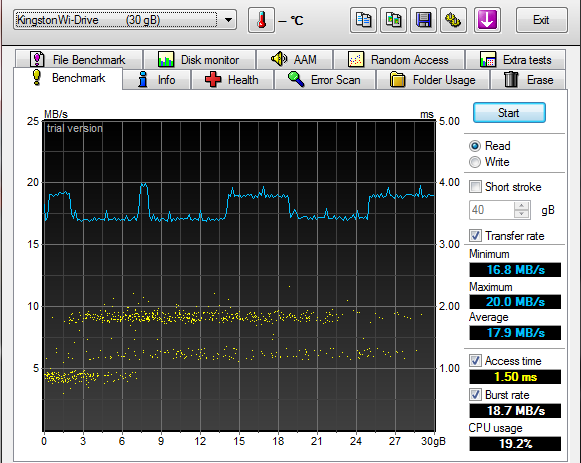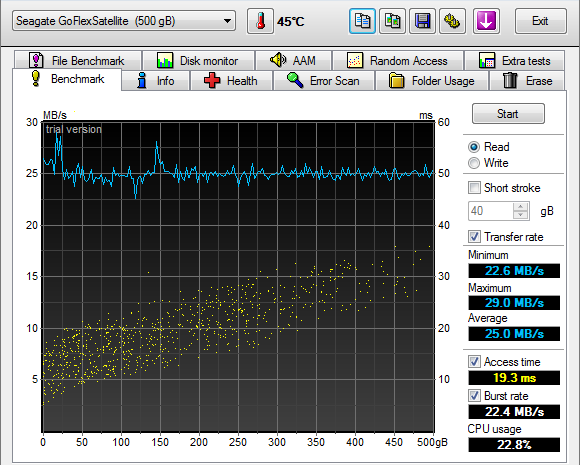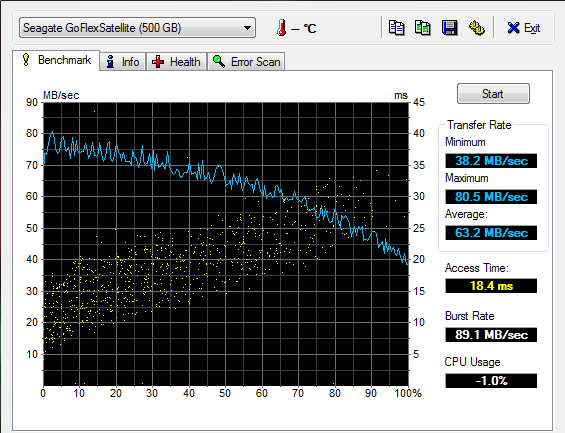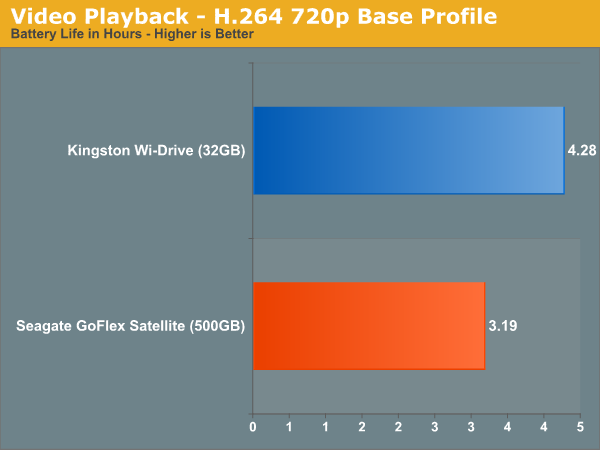Understanding Wireless Storage: Kingston Wi-Drive and Seagate GoFlex Satellite
by Vivek Gowri on November 21, 2011 2:30 PM ESTStorage and Wireless Performance
To test performance, I hooked both drives up to a PC and used HD Tune to get an idea of read performance and access time. The Kingston is USB 2.0 only and ends up performing roughly around the same level as the average USB flash drive. Access times are, as expected, significantly faster than the hard drive-based Seagate, but the NAND here is of the pretty low performance variety. Admittedly, this makes sense—cost and power consumption are far more important than outright speed in this type of application.

The Seagate has a SATA-to-USB 3.0 bridge, so it’s capable of significantly faster I/O speeds than the Wi-Drive. In the HD Tune graph over USB 2.0, we can see it’s basically pegged at the bandwidth limit of the interface (only around 25MB/s in this case, even though USB 2.0 can theoretically hit over 50MB/s). Switch to USB 3.0 and we get transfer rates typical of 5400RPM laptop drives.

GoFlex Satellite, USB 2.0

GoFlex Satellite, USB 3.0
Both drives are more than fast enough to stream high bitrate 720p video over 2.4GHz 802.11g/n, so long as you maintain a decent signal. I found that anything within 10 feet was good enough—I left both in a bag in the overhead bin on a 737 and connected just fine from my iPad at my seat. However, once you lose line of sight and start moving to distances of over 30 feet away from the streamer with a few walls and assorted furniture in between, you'll typically start to see some stuttering in the videos. That’s to be expected though, as it’s an extreme case for wireless range.
Battery Life
Battery life is an interesting topic. Kingston quotes a four hour battery runtime for the Wi-Drive while Seagate claims up to five hours on the Satellite's 10.36Wh battery, but it's not clear what kind of usage those figures represent. I fired up a trusty old loop of The Bourne Identity on each of the streamers playing through my iPad, placed the device two feet in front of the iPad, and unplugged it. I then time how long it is before the video dies, and that’s our winner.

Interestingly, the Kingston actually beat the claimed battery life spec, clocking in at 4:17, while the Seagate gave us pretty disappointing runtime at just under three and a quarter hours. It makes sense that the mechanical hard drive consumes more power, but it’s disappointing that our streaming HD video test undercut the claimed battery figures by that much.










32 Comments
View All Comments
sallenmd - Thursday, December 8, 2011 - link
They should be happy with the >3 hours of streaming on one charge. Mine gives out after 45 minutes streaming audio to a single iPadmillerm - Tuesday, March 25, 2014 - link
Did you guys happen to note the file system information about the file system that is actually used on the Wi-Drive. I have been trying to replace the usb stick and need to try and get the filesystem formatted in the correct way.